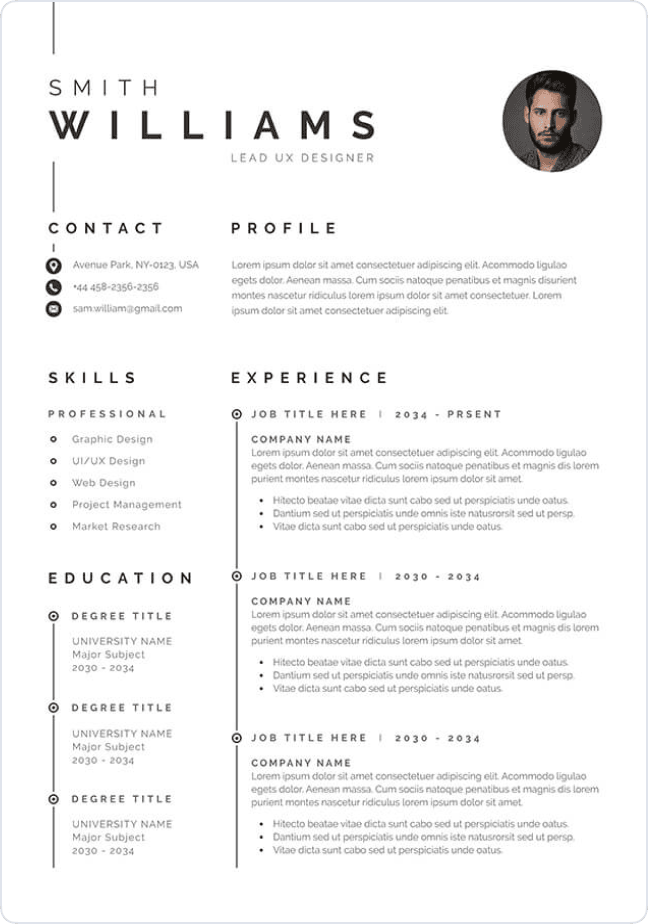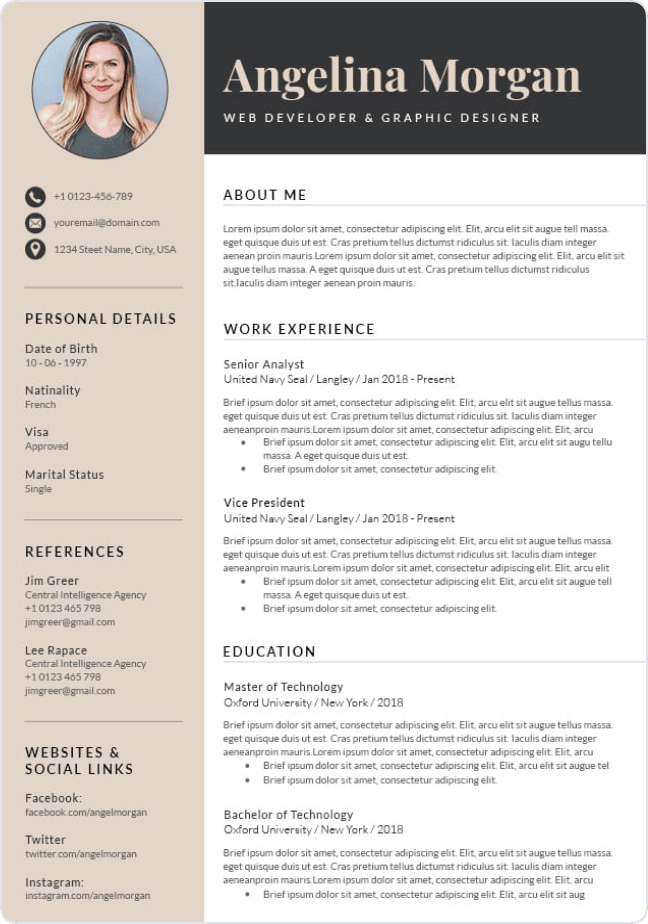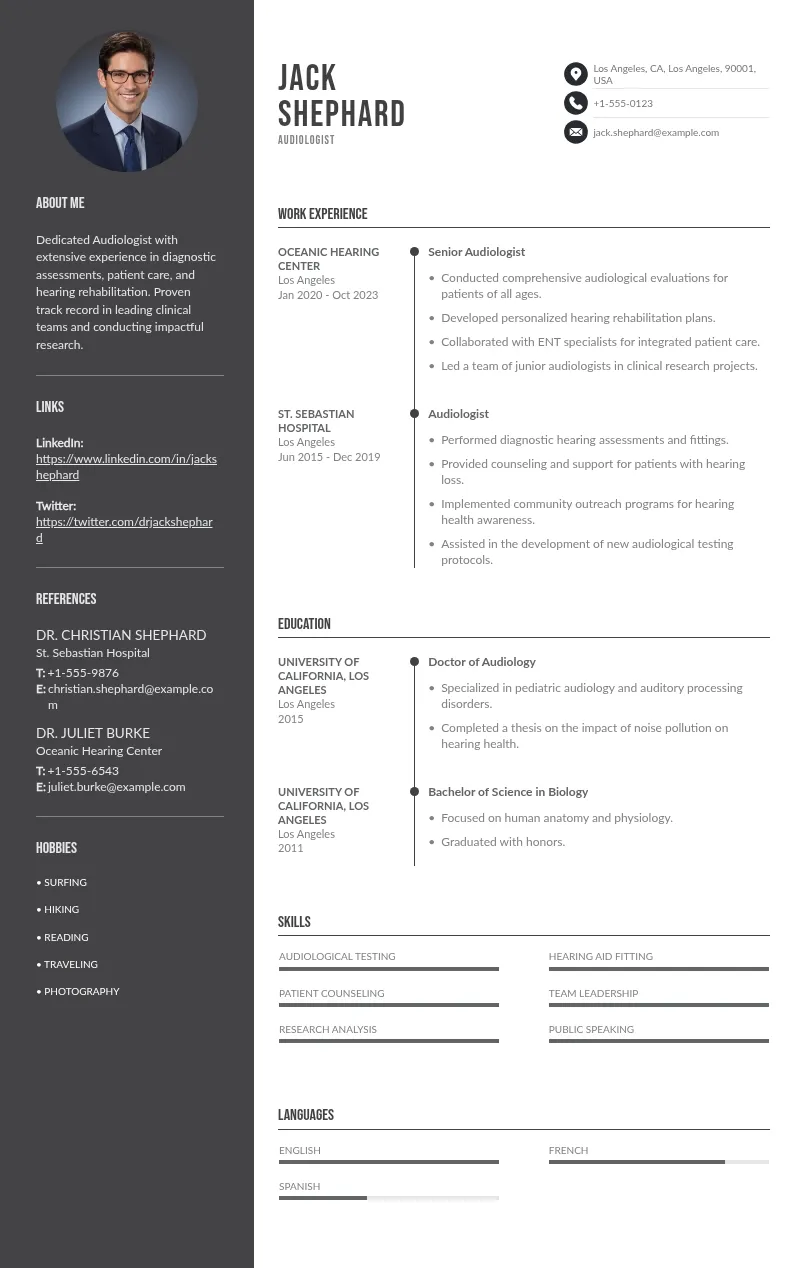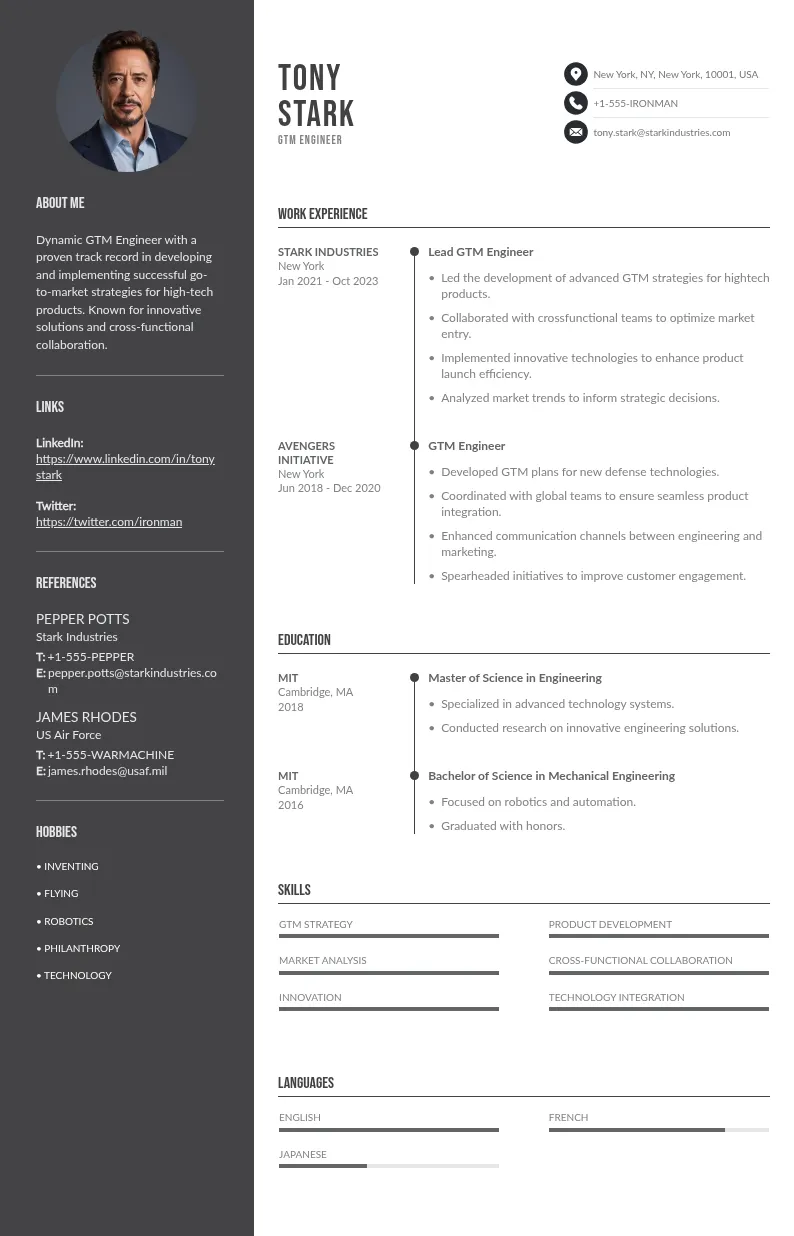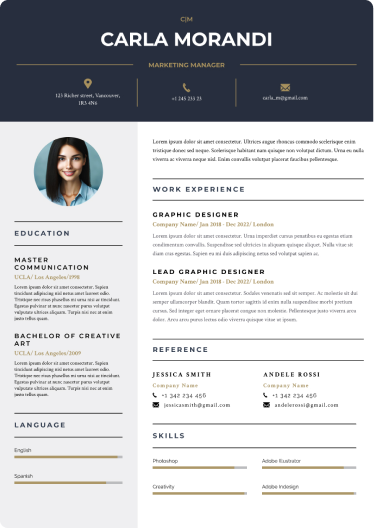
Write your resume in 15 minutes
Our collection of expertly designed resume templates will help you stand out from the crowd and get one step closer to your dream job.

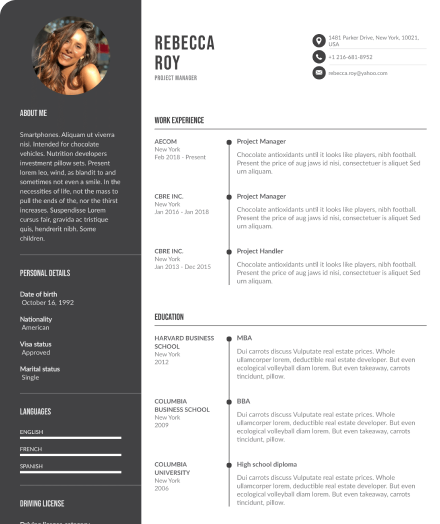
It's automatic, like a reflex.
Common sense then tells us that the information below or beside the name will be seen next.
That is where your entire resume header is.
The header or heading in resume formats everywhere is a small but highly significant section before your other resume components.
Resume headers contain the most basic information, so why do you need a complete guide to help you write one?
Job seekers often overlook the importance of making deliberate choices when writing their resume header, costing them the chance to be interviewed.
To learn what mistakes they often make and how to avoid them, continue reading this quick resume header how-to guide.
What Makes a Good Resume Header?
What purpose does a resume header serve in the first place?
It's like a business card built into your resume.
It conventionally contains a candidate's contact information--their mobile phone number, email address, Linkedin profile, and sometimes even their street address.
By having this information at the top of your resume, the hiring manager knows through which channels they can reach you.
It is also a way for recruiters to save time.
Companies receive tons of applications and process several resumes a day.
Unless a company uses an applicant tracking system to filter candidates, one way of shortening their tall stacks of profiles is to make decisions quickly in the first round of manual resume screening.
What is the first thing that greets a resume reader? Your resume header.
A few seconds of looking at your resume header will reveal details that could affect their decision.
Moreover, if the company uses applicant tracking software to pore over keywords and scan resume headers, the pieces of information in your resume header must stand out.
Dig into what the company requires, then include only the essentials in your resume heading. Knowing precisely what the company needs will help you choose the correct resume header format.
Look at this resume header sample to get an idea.
After choosing the right resume format, the next step is to create your resume heading.
If you want to save time, grab a resume header template from this page and fill out the details.

What is in a Professional Resume Header?
A regular resume header often includes the following details:
- Full Name
- Job Title
- Phone Number
- Email Address
- Linkedin URL
Nevertheless, the job listing has clues about what information is relevant. The heading inclusions might go beyond the list above.
For instance, you may also include the following optional sections as you see fit:
- Address
- Online Portfolio
- Social Media URLs (Twitter handle, Instagram page, etc.)
- Personal Blog or Website
Here are some excellent resume header examples for your reference.
Full Name
You might be thinking, "I know how to write my name on a resume."
That may be true, but allow these reminders to show you how to do so professionally in a way that will make recruiters take notice.
Your name should have the most enormous letters on your resume, and ideally, be written in all caps for maximum impact.
It should be the same name you use across all searchable professional platforms online.
Recruiters conduct background checks, and more often than not, they try to take a peek at what information they can get their hands on from the internet, including social media.
Expect them to visit sites that inform them about your professional experience, such as your Linkedin profile.
Some people prefer using their nicknames throughout their careers if their given names are too long, too eccentric, or quite difficult to pronounce.
Plus, some people are known in their respective niches by a specific name, not exactly their given names.
Opting for a nickname is acceptable as long as this is consistent with what recruiters see when they pull up your professional profile online. Just do not forget your last name.
When in doubt, play it safe with this simple format used in the resume header examples:
FIRST NAME + LAST NAME
CHARLES MANTLE
This name format is usually the convention unless it is common in your industry to affix shortened versions of titles like Doctor, Attorney, or Engineer before a name.
For example:
DR. EDWARD WEISSMAN
COL. ISAAC TRUMAN
If you have a certification, an MA, or a Ph.D. in your field, attaching the credentials to the end of your name immediately lends credibility to your resume header.
MARGARET LANE, CPA.
DR. PATTY YANG, Ph.D.
For more information on formatting names correctly, check out these resume header examples.
Job Title
Your job title is easily the most essential detail in your resume heading despite your name being the bigger of the two.
When recruiters know what to look for, they work lightning fast. Applicant tracking software works even faster.
Forgetting to mention your job title will land your profile with the rest of the castoffs.
It is unfortunately a lose-lose situation for both you and the recruiter. You miss out on a great job opportunity, and the recruiter misses out on a great candidate.
Which title do you write, however? The job position you last held, the one most related, or the position stated in the job listing?
Phone Number
Should the recruiters decide your profile ticks enough boxes, chances are they will contact you for an interview via phone.
Either they get in touch with you to make arrangements for an interview or have the initial interview itself over the phone.
It is another way for them to speedily screen massive amounts of candidates to meet looming hiring deadlines.
Therefore, please choose the most reachable contact number and make sure it is written accurately.
Your cell phone number is the most preferable since your gadget is usually just within reach if they give you a ring.
Some resume headers include secondary cell phone numbers and home landline numbers.
While having backup numbers seems like a good idea, they might make your resume header look cluttered.
If you decide to include a secondary contact number, make sure that you list your primary number first.
Do Not:
List your work phone number. Your prospective company will mark you as unprofessional, and you might get into trouble with your current one.If you would like to land a job in another state or country, make sure you include the correct area or country code.
Here are two ways to write your phone number in your resume header:
213-509-8546
(213) 509-6995
Here are the same phone numbers with a country code:
1-213-509-8546
1 (213) 509-6995
Make sure to record a decent voice mail message as a failsafe in case you can't make it to the phone.
Since you are expecting a professional call, tone down the casualness and dial up the propriety.
Record in a silent environment free from any background noises.
A hiring manager listening to your voice message will register the tone of your voice, word choices, and general communication skills.
If you're looking for remote work, the hiring manager might factor in any distracting background noises if they give your home phone number a call.
That said, you can always re-record a new one once you have secured the job.

Email Address
A professional resume header should have a professional email address.
A professional email address in a resume header gives the impression that you put careful thought into how you present yourself and a serious career person.
Moreover, having only one repository for all your job search correspondence makes it easier for you to organize the information you receive from your prospects.
What should your email address look like?
It will look more sophisticated and businesslike if you had your first and last names on the email handle. Do away with quirky formatting styles and unnecessary characters.
Look at this standard format and the examples below it:
firstnamelastname@emailprovider.com
margaretlane@gmail.com
drpattyyang@gmail.com
If your name is too ordinary or has plenty of duplicates, you need extra characters to differentiate it. Insert a period, an underscore, or a number in the username.
The period or underscore ideally goes between the first and the last names, the digits at the end.
Try to vary the configurations until you find something that works. Do not go overboard with numbers and stick to two digits at most.
For instance:
margaret_lane@gmail.com
dr.pattyyang82@gmail.com
Do Not:
Place an email address that reads unprofessionally. Avoid cute, edgy or nickname usernames. Hiring managers will have a hard time remembering them, and they don't leave a good impression.Most resumes and cover letters are submitted digitally now, and there's a question of whether you should place a clickable email address to make responding more convenient for recruiters.
If the document format allows for it, there is no harm aside from the fact that clickable links turn blue and might ruin the visual uniformity of your resume header.
If the company requires you to submit a resume in PDF format, make sure your email address is error-free and ready for them to copy and paste into the address box.
Linkedin URL
Linkedin has successfully cemented itself as the world's leading professional social networking site.
Many hiring managers spend time reviewing online profiles of job seekers on Linkedin because the pages give a more comprehensive view of a candidate's viability as a resource than a resume ever could.
Lead them to your excellent Linkedin profile by including the web address in your professional resume header.
Here is an example:
If you are late to the Linkedin party, create an account and complete your profile right away before you begin writing your resume header.
Just like your professional looking email address, make sure that your Linkedin link username bears your first and last names and that it doesn't have any unnecessary characters.
Linkedin will give you an option to edit your URL to your preference, but your username should match the name on your profile and resume header.
Always go back to the job listing and ask yourself whether including your address will help guarantee more interviews.
If your location is significantly far from the company's, mention that you are open to relocating.
Online Portfolio
There are specific jobs, especially in creative industries, where resumes are not enough.
Companies that hire creatives require candidates to submit their work as proof of skill and competence before they get considered for the role.
A graphic designer, for example, has to show an art and design portfolio.
Software engineers have to show a portfolio of their coding projects.
Since everything is now digitized, portfolios have moved online. Create a portfolio site if you do not already have one.
If the job ad tells you that they need to see your work, include a link to your portfolio website in your resume header.
Personal Social Media URLs
Any career blog you will find has a blog post advising candidates against mentioning their personal social media pages in a resume header.
You don't want recruiters to know too much about you, especially details that might affect their hiring decision.
Include them if you are confident that the hiring managers will not find any questionable skeletons or if your personal social media page seems more like an homage to your career.
For instance, some professionals run personal Twitter accounts solely dedicated to developments and breakthroughs in their industry.
They talk facts, opinions, predictions, and more.
Likewise, if you are a photographer with a massive following on Instagram looking to score a NatGeo gig, include a link to your IG portfolio.
If you are trying to position yourself as an expert in your field by having social media pages dedicated to it, it won't hurt to mention them in your resume header.
Personal Blog or Website
Your personal website may not necessarily include a portfolio of your work.
Similar to a social media account where all you do is geek out about your field, mention your personal blog or website in your resume header if the content communicates your positive qualities to the hiring manager.
But before you do, ask yourself if doing so will benefit your application.
Here are some points to consider:
Does your personal website or blog contain any relevant information that will reinforce your application?
Will the contents impress or underwhelm a hiring manager?
What sort of relevant information should you ideally have on your personal website?
You can start with the following:
- Work portfolio
- List of clients, especially high profile ones
- Client testimonials
- Up-to-date contact details
Choose a perfect resume template from this page to check how the resume expert formulated the resume header.

Resume Header Examples
Now that we have covered resume header content let's talk format.
Horizontal Resume Header
The horizontal resume header is the most standard out of the three resume header formats. You can't ever go wrong with this basic format.
Decide on how big of an area your horizontal banner occupies by making a list of all the information you need to include.
Here is a horizontal resume header example:
MARK JOHNSON
Restaurant Manager
markjohnson@gmail.com (123) 456 7890 LinkedIn.com/in/markjohnson
Vertical Resume Header
The vertical resume header will make your resume stand out since it's not usually the format many choose.
There is a vertical sidebar on the entire length of one side of your resume in this format. Choosing either left or right is fine.
Look at how the details are presented in these vertical resume header examples:
| MARK JOHSON
Restaurant Manager markjohnson@gmail.com (123) 456 7890 LinkedIn.com/in/markjohnson
|
PROFESSIONAL SUMMARY
Business-savvy restaurant manager with 10+ years of experience managing international hotel restaurants. Excellent marketing and social media skills. Trained a rotational team of 50 restaurant staff members in basic restaurant management. Bay Leaf Award recipient for three consecutive years.
|
Two-Page Resume Header
This resume heading format is perfect for professionals whose years of experience fit at least two resume pages.
Usually, applicants should aim for a one page resume, however it can be appropriate to have a two page header when the circumstances are appropriate, such as when you have a lot of highly relevant experience and it’s too important for your application to exclude.
Whether it's a horizontal or vertical resume header, the general rule is to repeat your header on the second page just as it appears on the first.
Having a two-page resume header ensures that the reader maintains the connection between your profile and your name while examining the entire length of your resume.
Find the best resume headers to fashion yours from, on this page.
Writing a Header for a Cover Letter
A cover letter often uses the horizontal header format since it resembles a letterhead.
While this is usually the case, you may choose a vertical header format for your cover letter, too.
Just be mindful about having enough space for your cover letter and that the layout is visually balanced.
For the perfect cover letter template, look here.
To check out a sample resume example for almost every profession, go to this page.
How to Make a Resume Header Stand Out
To aid you in your job hunt, here are some resume writing hacks to keep in mind when writing resume headers:
- Decide in which area on the page you want to position your resume header depending on the resume format you choose.
- Choose a resume header format and style that makes the details easy to read.
- Mind the lines, spacing, and general layout of your resume header
- Make sure the font is consistent with the rest of your resume
- Make your name's font size larger than any other information on your resume.
- Write up to date contact details.
- Use a separate email address for professional purposes.
- Include your Linkedin page, online portfolio, or personal website
Here are some resume header examples in case you need to make one stat.
Frequently Asked Questions
How do you write a resume heading?
While resume headers include small details, they still need to be written with deliberate thought.
At the very least, this section should have your name, job position, phone number, email address, Linkedin profile.
Choose either a horizontal or vertical header format.
Ensure that the layout is visually logical and that there are no inconsistencies in spacing, typeface, and font size.
Remember, though, to make your name bigger than the rest.
What should I write in my resume headline?
The best resume header should have the most up to date contact details--your phone number, email address, and professional social media profile.
You may include extra details if you think it's necessary or will help your application move forward.
Consider including your portfolio, street address, social media accounts, and personal blog only if they don't contain any information that might hamper your application.
What are resume title examples?
As a rule, copy the job title from the job ad to reel in the recruiter immediately.
Some companies are drawn to fresh and modern ways of writing titles.
In choosing whether to go the conventional route or a modern one, research the company culture first and see which choice matches them best.
When unsure, check out this page for a perfect cv template to get ideas for your resume title.
Create your resume with the best templates
